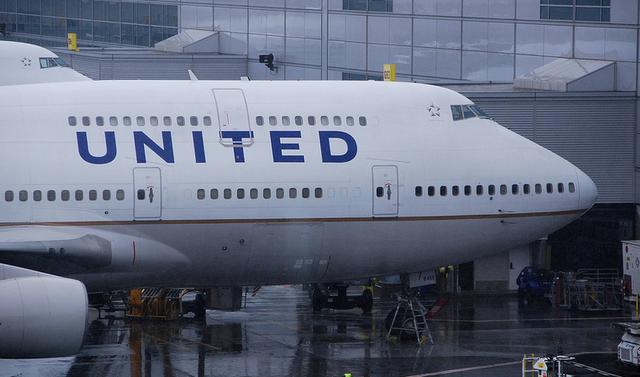10 Things We Learned About United Airlines’ Efforts To Not Annoy Customers
Five years after United Airlines and Continental finalized their mega-merger, the resulting carrier has struggled to deal with both unhappy passengers and employees, and remains at the back of the customer satisfaction pack among the nation’s major airlines.
Bloomberg took a look at the past five years at United, from its disastrous combination of reservation systems with Continental to its rush to replace two CEOs in just two months. The report is full of eye-opening information about the carrier and its leaders.
Here are 10 things we learned about United’s long road to possible redemption, and the problems that marred the carrier’s efforts along the way.
1. Problems were evident right from the start. Under the direction of then-CEO Jeff Smisek (a holdover from Continental), Bloomberg contends that the merged airline failed to focus on the nuts and bolts of the business, like ensuring that flights left and landed on time, and building in allowances for severe weather and mechanical issues that could lead to delays.
2. Leadership was also ill-prepared to deal with the logistical and technical hurdles of combining the systems of two huge carriers, resulting in widespread — but avoidable — delays and outages.
“Rather than combining the carriers’ reservations systems, websites, and frequent-flier programs over time, the company merged all three on the same day, maximizing disruption and confusion,” Bloomberg reports. “And in adopting the passenger service system from Continental, the smaller of the two airlines, United had to train a much larger number of people to use different software.”
In all, the merger proved catastrophic, with the scheduling program losing track of pilots, or assigning flights to pilots who no longer worked for the company, leading to cancellations.
3. Employees say that the merged airline mistakenly put its focus on cost-cutting through layoffs, furloughs, and outsourcing jobs like baggage handling and gate agents.
In some cases, employees say things got so bad they were discouraged from giving vouchers to unhappy customers who had been bumped from their flights, Bloomberg reports.
4. The unhappy employees then led to unhappy customers. As one airline analyst puts it: “Unhappy mechanics do not tend to go the extra mile—or the extra foot—to get the airplane ready to go.”
Soon, travelers caught on to the discontent: one frequent United passenger tells Bloomberg that employees were nice people, but “they are in such a horrible situation, constantly trying to deal with customers that are not happy, and they’re completely powerless.”
5. From there things just got worse. The airline saw spikes in customer complaints. In 2012, according to the U.S. Department of Transportation, United was responsible for 43% of all consumer complaints filed against U.S. airlines.
Additionally, the carrier endured flight disruptions because of technical glitches, and a string of customer stories that alleged the airline treated disabled passengers poorly or lost baggage.
Last week, the Department of Transportation levied a $2.8 million fine against the airline for long tarmac delays and the poor treatment of disabled passengers.
6. The airline has seen three changes of leadership since it merged with Continental in 2010. Smisek led the company during the merger process until he resigned unexpectedly in September 2015 amid a Department of Justice investigation into whether the airline had tried to improperly influence the Port Authority of New York & New Jersey, which operates the region’s major airports.
The company then appointed Oscar Munoz to the helm, and he quickly took on the task of not only apologizing for merger mistakes but fixing the issues. However, he suffered a heart attack after just one month on the job. An interim leader was then appointed. Brett Hart also serves as the carrier’s general counsel, and plans to serve as CEO until Munoz’s return from a heart transplant sometime this spring.
7. When Munoz took over the airline last fall, he immediately began to implement a new message that the airline would do better, and make up for its past mistakes.
Although Munoz’s tenure was cut short, his interim replacement, Hart, has picked up where he left off. Since taking over in October, Hart has helped to forge agreements with the leadership of the airline’s mechanics union, and announced contract extensions with pilots, Bloomberg reports.
8. Five years after the airline merged with Continental Airlines, the combined carrier finally saw a profitable quarter. The second quarter of 2015 was the airline’s most profitable ever, with $1.3 billion in net income, excluding special items. In the third quarter, it climbed to $1.7 billion, Bloomberg reports.
To address these issues, the airline’s “customer experience” team waded through thousands of customer complaints recently to find out just what customers liked the least about United.
In the end, the team determined it was the boarding process put in place in 2013. Now, the airline says that issue is fixed. Other issues addressed included offering free snacks and revamping coffee choices.
9. United is also focusing on its performance. Bloomberg reports that in recent months, the carrier has improved on-time and missed-connection metrics. It’s also seen a decrease in rate of mishandled baggage.
“We’re trying to find more of a balance between scheduling an airline for maximum efficiency from an asset perspective as opposed to operations,” Andy Buchanan, managing director of international network planning, tells Bloomberg. “We’re finding, I think, a better middle ground.”
10. But while the improvements are a bright spot for United, analysts say the carrier has a long way to go.
It’s primed for improvement,” Vicki Bryan, a transportation analyst at Gimme Credit tells Bloomberg. “But I still see this company very much in limbo.”
United’s Quest To Be Less Awful [Bloomberg]
Want more consumer news? Visit our parent organization, Consumer Reports, for the latest on scams, recalls, and other consumer issues.


